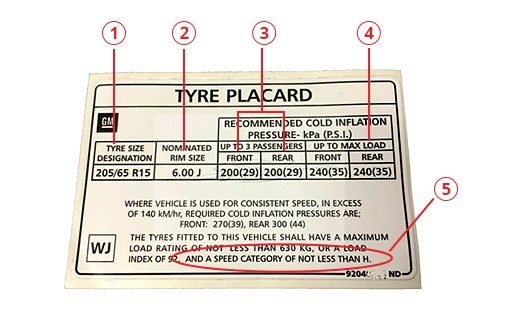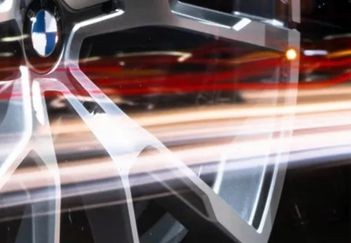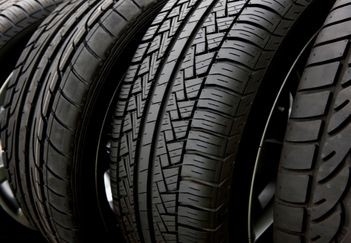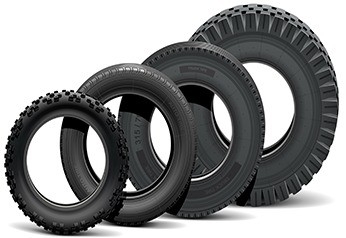
November 30, 2022
How to Read Your Tyre Placard Sticker
Have you noticed that little sticker on the side of your car door? That's your vehicle's tyre placard sticker.
Found on other parts of your vehicle, your tyre placard is proof of the combined importance of your wheels and tyres, as they work together to keep you safe and stable on the road.
The words and numbers might not make much sense at a glance, but if you learn to read them, you'll find valuable information about your tyres and wheels that will keep you safe while driving.
In fact, the tyre placard reflects the information etched on your sidewall in a more detailed way. In this article, you'll learn the importance of tyre placards, what they tell you, and how you can use them to ensure a safe ride.

What Is a Tyre Placard?
A tyre placard is usually a sticker found in/on the:
• Vehicle's glove box
• Driver's door jamb
• Fuel tank cap
• Vehicle's front bonnet
In 1973, this tyre sticker became a legal requirement for new passenger cars, 4x4s and light trucks. Generally, it contains the vehicle manufacturer's recommendations on air pressure, load capacity, speed rating and other aspects. All this information can help you use your tyres properly, drive safely, and choose the right tyre replacements.
How Do I Read My Tyre Placard?
Reading your tyre placard becomes easier when we break down the information it contains. Take note that tyre placards have different layouts. But even if they don't look alike, they include the same basic details.

1. Tyre Size
• The first letter refers to the tyre type. P means passenger, LT stands for light truck, and ST is for special trailer.
• The following number is your tyre width or section width, which measures the distance from one sidewall to another in millimetres.
• After the slash is the aspect ratio or the height of the tyre from the rim to the tread, in relation to the tyre width. A value of 65 means that the tyre's height is 65% of its width.
• Next is a letter, which refers to the tyre's internal construction. R stands for radial, the most common way tyre companies manufacture tyres today. D stands for diagonal or bias-ply construction.
See one or two tyre sizes beneath the original one? Those are the tyre size alternatives you can also use for your vehicle.
2. Rim Size
• This number refers to the wheel's width in inches. If the value is 6 inches, you can convert it to millimetres by multiplying it by 25.4. So, 6 inches = 152.4 millimetres.
• The letter indicates the tyre bead or contour profile. The wheel edges should match your tyres so the latter can be fitted perfectly. Here is a list of standard tyre bead profile symbols and their uses.
3. Tyre Pressure
This number represents the recommended air pressure for your tyres. The numbers noted on your tyre placard are specific, with different values for the front and rear axles and for normal and maximum loads.
The numbers are in Kilopascals (kPa), followed by the pounds per square inch (PSI) in parentheses. Remember that these are the recommended values in normal driving conditions. For example, increasing tyre pressure is recommended when adding to your load or driving faster.
Check your tyre pressure when they are cold to get an accurate measurement. Never let your vehicle carry more than the maximum load—and take note of the different values for the front and rear tyres.
4. Load Rating
The load rating is sometimes represented by a number or stated explicitly. Aside from letting you know the maximum weight your vehicle can carry, the load rating helps you choose new tyres. Fitting tyres with a lower load rating can cause tyre damage, blowouts, and penalties since this is illegal.
Here's a tyre load rating chart to guide you:
| Code | Weight | Code | Weight | Code | Weight | Code | Weight |
|---|---|---|---|---|---|---|---|
| 80 | 450 kg | 90 | 600 kg | 100 | 800 kg | 110 | 1060 kg |
| 81 | 462 kg | 91 | 615 kg | 101 | 825 kg | 111 | 1090 kg |
| 82 | 475 kg | 92 | 630 kg | 102 | 850 kg | 112 | 1120 kg |
| 83 | 487 kg | 93 | 650 kg | 103 | 875 kg | 113 | 1150 kg |
| 84 | 500 kg | 94 | 670 kg | 104 | 900 kg | 114 | 1180 kg |
| 85 | 515 kg | 95 | 690 kg | 105 | 925 kg | 115 | 1215 kg |
| 86 | 530 kg | 96 | 710 kg | 106 | 950 kg | ||
| 87 | 545 kg | 97 | 730 kg | 107 | 975 kg | ||
| 88 | 560 kg | 98 | 750 kg | 108 | 1000 kg | ||
| 89 | 580 kg | 99 | 775 kg | 109 | 1030 kg |
5. Speed Rating
Your tyre's speed rating may be represented by its category symbol. This is the maximum speed your tyre can travel while carrying its full load. Here's a chart of symbols and their corresponding speeds.
| Speed Symbol | Km/h |
|---|---|
| N | 140 |
| P | 150 |
| Q | 160 |
| R | 170 |
| S | 180 |
| T | 190 |
| U | 200 |
| H | 210 |
| V | 240 |
| Z | 240+ |
| W | 270 |
| Y | 300 |
If you have a 4x4 vehicle, you may notice that it has two tyre placards—one for a passenger application and the other for a light truck. Both have different recommendations for tyre pressure, depending on the tyre's size and load.
Why Is Your Tyre Placard Important?
You can quickly locate your tyre placard to refer to it at a moment's notice. Here are some instances when it comes in handy:
• Inflating your tyres
You've decided to pull up to a petrol station to load your tyres with some air. How much air do your tyres need? You can check your tyre placard.
Underinflation is the leading cause of flat tyres and tyre failure. If you want your tyres to last longer, ensure they have enough air. When tyres have low pressure, a bigger surface area touches the ground, increasing friction. This produces excessive heat that may lead to premature wear and blowouts.
• Loading your vehicle
Going on a road trip? Or moving houses? Check how much weight your tyres can handle using your tyre placard.
Overloading your vehicle also causes tyre failure, which may damage your tyres and vehicle. Worse, it may lead to accidents, harming you, your passengers, and other motorists. The tyre placard may also indicate the proper pressure and load rating for towing or ask you to refer to the owner's manual.
• Changing your tyre size or wheels.
Check your tyre placard if your purchasing wheels and tyres differ from your vehicle's original equipment (OE) fitments. It conveniently suggests wheel and tyre combinations and can serve as a guide for you and the fitter. Remember that changing the wheel size requires adjusting the tyre size. When you alter the tyre size, it most certainly needs a new minimum tyre pressure that you need to calculate.
The Final Word
Your tyre placard provides a wealth of helpful information. Knowing how to read and use it will keep you safe during daily drives and if you decide to alter your vehicle. As they say, knowledge is power!
Consult your tyre placard when changing your wheels or tyres, and visit Tyroola to buy them! We offer the lowest prices online, thanks to our Price Match Guarantee. We also have a wide selection of tyre sizes that keep you rolling in style and within budget.
Shop at Tyroola to get the best deals and promos in town!




